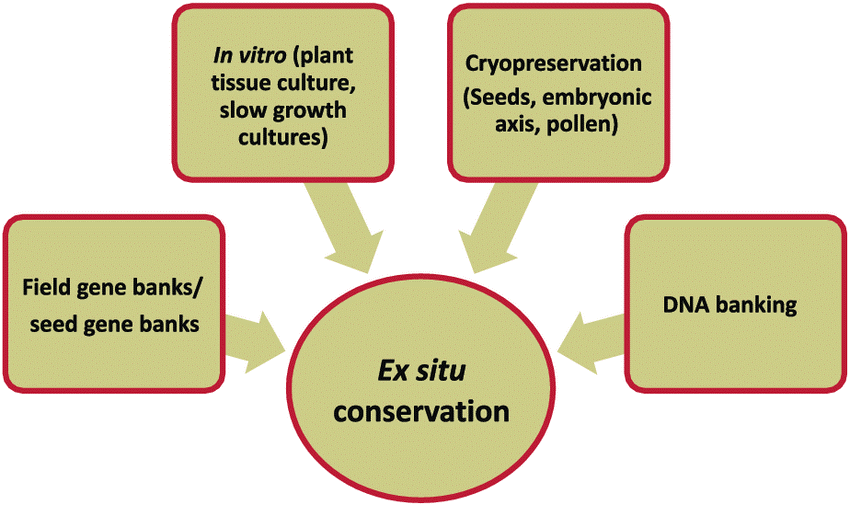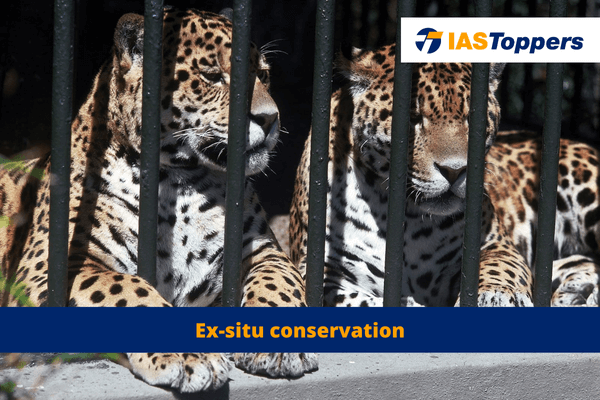Ex situ conservation or off-site conservation, is a process of preserving an endangered species, variety, or breed of plant or animal outside of its natural habitat, such as by relocating a portion of the population from a threatened habitat and housing it in a new artificial habitat that is similar to that animal’s natural habitat while also being cared for by people. Zoos and wildlife sanctuaries are two examples of such artificial habitats.
Table of Content
- What is Ex situ Conservation of biodiversity?
- Ex situ Conservation Facilities
- Advantages of Ex situ conservation
- Disadvantages of Ex-Situ Conservation
- Frequently Asked Questions (FAQs)
What is Ex situ Conservation of biodiversity?
- Meaning: Ex situ conservation is the process of protecting threatened animals and plants outside of their natural habitat.
- Ex situ Conservation can be done in a variety of methods, including:
- Keeping animals in zoological parks and wildlife safari parks.
- Growing plants in botanical gardens.
- Preserving gametes, eggs, and seeds in cryopreservation facilities.
- Using tissue culture to propagate plants.
- Ex situ conservation is an important tool for protecting biodiversity, as it can help to ensure the survival of threatened species even if their natural habitats are destroyed.

Ex situ Conservation Facilities
Botanical Gardens
- Botanical gardens are a type of ex-situ conservation facility that is dedicated to the collection, cultivation, and display of plants.
- Botanical gardens play an important role in ex-situ conservation by:
- Providing a safe haven for threatened plants.
- Studying threatened plants and their ecology.
- Educating the public about threatened plants and the importance of conservation.
- Botanical Garden of Indian Republic:
- The Botanical Garden of Indian Republic is a new botanical garden that was established in 2002.
- Location: Noida, near Delhi
- The main objectives of the garden are:
- To conserve and propagate important threatened plant species.
- To serve as a center of excellence for conservation, research, and training.
- To raise public awareness about plant diversity and the need for conservation.
Zoological Gardens
- Zoological Gardens or ‘Zoos’ are another type of ex-situ conservation facility that is dedicated to the care and breeding of animals.
- Zoos play an important role in ex-situ conservation by:
- Providing a safe haven for threatened animals.
- Studying threatened animals and their ecology.
- Educating the public about threatened animals and the importance of conservation.
Gene Banks
- Gene banks are institutions that collect and store genetic material from plants and animals.
- They play an important role in ex situ conservation by providing a safe and secure place for genetic material to be stored for future use.
- Gene banks also research the conservation and use of genetic material.
- They also educate the public about the importance of biodiversity and the need for conservation.
- Examples of gene banks:
- National Bureau of Plant Genetic Resources (NBPGR), New Delhi, India.
- National Bureau of Animal Genetic Resources, Karnal, Haryana, India.
- National Bureau of Fish Genetic Resources, Lucknow, India.
Conservation at molecular level (DNA level)
- Conservation at molecular level is a new technique that is being used to conserve genetic material.
- It involves the cloning of DNA and the storage of DNA in its native state.
- Conservation at molecular level is a promising technique for the conservation of genetic material, as it can be used to store genetic material from plants and animals that cannot be stored in gene banks.
Advantages of Ex situ conservation
- Protection from rapid environmental change: Species are protected from rapid and unpredictable changes in their natural habitats caused by human activity or climate change.
- Supporting endangered species recovery: A species’ needs can be better assessed, and recovery strategies can be created by removing individuals from their natural habitat and bringing them to a controlled environment.
- Promoting research and education: Ex-situ conservation can provide an ideal opportunity for scientific research and education. Researchers can observe species’ behaviour closely without disrupting the natural environment. Utilizing these facilities as educational tools can contribute to public awareness about biodiversity and foster active participation in conservation initiatives.
- Increasing genetic diversity: By transferring members of a species from one location to another, genetic diversity within the species can be increased. This can help ensure the species’ survival by giving them access to a wider range of genetic material and promoting genetic flexibility.
- Enabling reintroduction programs: Once species populations are restored to their natural habitats, ex-situ conservation programs can provide a source for reintroducing individuals into the wild. It also helps to ensure the continuity of species in their native habitats.
Disadvantages of Ex-Situ Conservation
- Expense: Building and maintaining off-site habitats can be very expensive, especially if the necessary resources are unavailable locally. In addition, transporting organisms to their new homes can add to the overall costs.
- Limited genetic diversity: When organisms are taken out of their native habitat, their genetic diversity is often limited. In certain instances, this situation may result in limited genetic diversity, which has the potential to impede their capacity to adjust and endure within their unfamiliar surroundings.
- Stress: Moving an organism from one habitat to another can be very stressful, leading to physical and emotional health issues. Moreover, the strain can render the organism more susceptible to illness or predation within its novel habitat.
- Inaccurate representation: Ex-situ conservation does not always accurately represent the original habitat of the species being conserved. As a result, this implies that the species might lack access to comparable sources of sustenance, natural adversaries, or other environmental factors that it would have encountered in its native habitat.
- Unpredictable results: Because ex-situ conservation involves manipulating nature in a controlled environment, the results can be unpredictable. There is always a chance that something unexpected could happen and cause unforeseen problems or endangerment to the species being conserved.
Conclusion
Ex situ conservation plays a pivotal role in safeguarding biodiversity by providing safe havens for endangered species and facilitating research and education. While it offers a strategic approach to species preservation, it also presents challenges and costs, underscoring the necessity for a balanced integration with in situ conservation efforts.
Ref: Source-1
| Other Articles in Environment & Disaster Management | |
| In-situ conservation | Ramsar convention |
| Wildlife Protection Act 1972 | National Green Tribunal |
| Wildlife trust of India | Compensatory Afforestation |
FAQs (frequently asked question)
What is Ex situ conservation?
Ex situ conservation is the process of protecting threatened animals and plants outside of their natural habitat.
What is ex situ bioremediation?
Ex-situ bioremediation is a biological procedure in which processed excavated soil is placed in a lined above-ground treatment area and aerated to improve the native microbial population’s ability to degrade organic contaminants.
Is Ex situ conservation of biodiversity practical?
Yes, but when Ex situ conservation is carried out correctly. Ex-situ biodiversity conservation can be a very effective and practical way of preserving species and habitats. However, it requires extensive planning, monitoring, and management.
What is the difference between in-situ and ex-situ conservation? Or What is in-situ and ex-situ conservation?
In situ and ex situ, which are Latin for “in” and “out” of place, describe the location of wildlife. In situ conservation refers to the animal’s natural habitat, whereas ex situ conservation refers to conservation in which the animal has been relocated.
What are examples of ex-situ conservation? OR
What are examples of in-situ conservation? OR
What are examples of ex-situ conservation and in-situ conservation?
Ex-situ conservation includes zoological gardens, seed banks, gene banks etc.
In-situ conservation includes national parks, wildlife sanctuaries, biospheres reserve etc.


